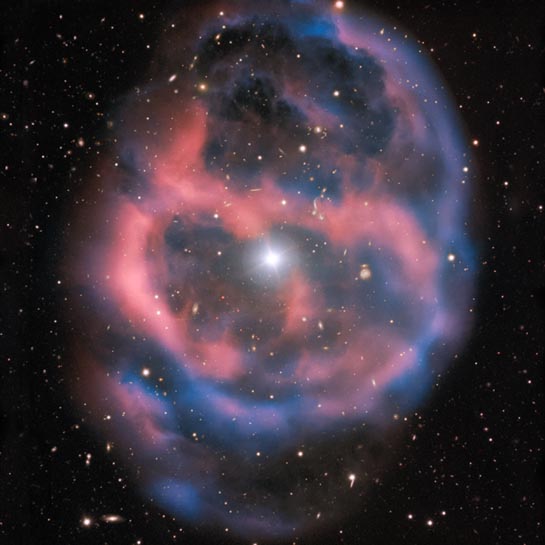
Planetary Nebula
RA 13h 40m 41.37s Dec -19° 53' 6.74"
Virgo
ESO
1400 light-years
6.76 x 7.36 arcminutes
North is -0.0° left of vertical
ESO
January 22, 2019
ABOUT THIS IMAGE:
The faint, ephemeral glow emanating from the planetary nebula ESO 577-24 persists for only a short time - around 10,000 years, a blink of an eye in astronomical terms. ESO's Very Large Telescope captured this shell of glowing ionized gas - the last breath of the dying star whose simmering remains are visible at the heart of this image. As the gaseous shell of this planetary nebula expands and grows dimmer, it will slowly disappear from sight.
An evanescent shell of glowing gas spreading into space - the planetary nebula ESO 577-24 - dominates this image [1]. This planetary nebula is the remains of a dead giant star that has thrown off its outer layers, leaving behind a small, intensely hot dwarf star. This diminished remnant will gradually cool and fade, living out its days as the mere ghost of a once-vast red giant star.
Red giants are stars at the end of their lives that have exhausted the hydrogen fuel in their cores and begun to contract under the crushing grip of gravity. As a red giant shrinks, the immense pressure re-ignites the core of the star, causing it to throw its outer layers into the void as a powerful stellar wind. The dying star's incandescent core emits ultraviolet radiation intense enough to ionize these ejected layers and cause them to shine. The result is what we see as a planetary nebula - a final, fleeting testament to an ancient star at the end of its life [2].
This dazzling planetary nebula was discovered as part of the National Geographic Society -Palomar Observatory Sky Survey in the 1950s, and was recorded in the Abell Catalogue of Planetary Nebulae in 1966 [3]. At around 1400 light years from Earth, the ghostly glow of ESO 577-24 is only visible through a powerful telescope. As the dwarf star cools, the nebula will continue to expand into space, slowly fading from view.
This image of ESO 577-24 was created as part of the ESO Cosmic Gems Programme, an initiative that produces images of interesting, intriguing, or visually attractive objects using ESO telescopes for the purposes of education and public outreach. The programme makes use of telescope time that cannot be used for scientific observations; nevertheless, the data collected are made available to astronomers through the ESO Science Archive.
This stunning planetary nebula was imaged by one of the VLT's most versatile instruments, FORS2. The instrument captured the bright, central star, Abell 36, as well as the surrounding planetary nebula. The red and blue portions of this image correspond to optical emission at red and blue wavelengths, respectively.
An object much closer to home is also visible in this image - an asteroid wandering across the field of view has left a faint track below and to the left of the central star. And in the far distance behind the nebula a glittering host of background galaxies can be seen.
Notes:
[1]
Planetary nebulae were first observed by astronomers in the 18th century?-?to
them, their dim glow and crisp outlines resembled planets of the Solar
System.
[2] By the time our Sun evolves into
a red giant, it will have reached the venerable age of 10 billion years.
There is no immediate need to panic, however - the Sun is currently only
5 billion years old.
[3] Astronomical objects often have
a variety of official names, with different catalogues providing different
designations. The formal name of this object in the Abell Catalogue of
Planetary Nebulae is PN A66 36.